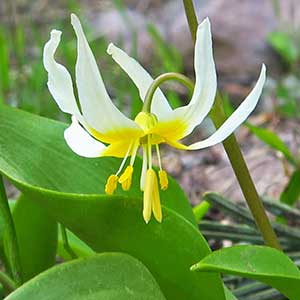Erythronium helenae
Erythronium klamathense
Mount St. Helena fawn-lily, Pacific fawnlily, St. Helena fawn lily
Klamath fawn-lily
ovoid, 30–55 mm, sometimes producing sessile bulbels.
slender, 25–40 mm.
7–20 cm;
blade mottled with irregular streaks of brown or white, broadly lanceolate to ovate, margins ± wavy.
6–17 cm;
blade green, lanceolate to narrowly elliptic, ± folded along midvein, margins entire to wavy.
12–30 cm.
6–20 cm.
1–3-flowered.
1–3-flowered.
fragrant;
tepals ± white, bright yellow at base, pinkish in age, lanceolate to ovate, 25–40 mm, inner with small auricles at base;
stamens 8–13 mm;
filaments ± yellow, linear, ± slender, less than 0.8 mm wide;
anthers yellow;
style ± white, often bent to one side, 5–8 mm;
stigma unlobed or with lobes shorter than 1 mm.
tepals 2/3 or more white, with yellow zone at base, ± pinkish in age, broadly lanceolate, 20–35 mm, inner with small auricles at base;
stamens 8–14 mm;
filaments white, slender;
anthers ± yellow;
style white, 4–9 mm;
stigma ± unlobed.
obovoid, 2–4 cm.
narrowly obovoid, 2–5 cm.
= 24.
= 24.
